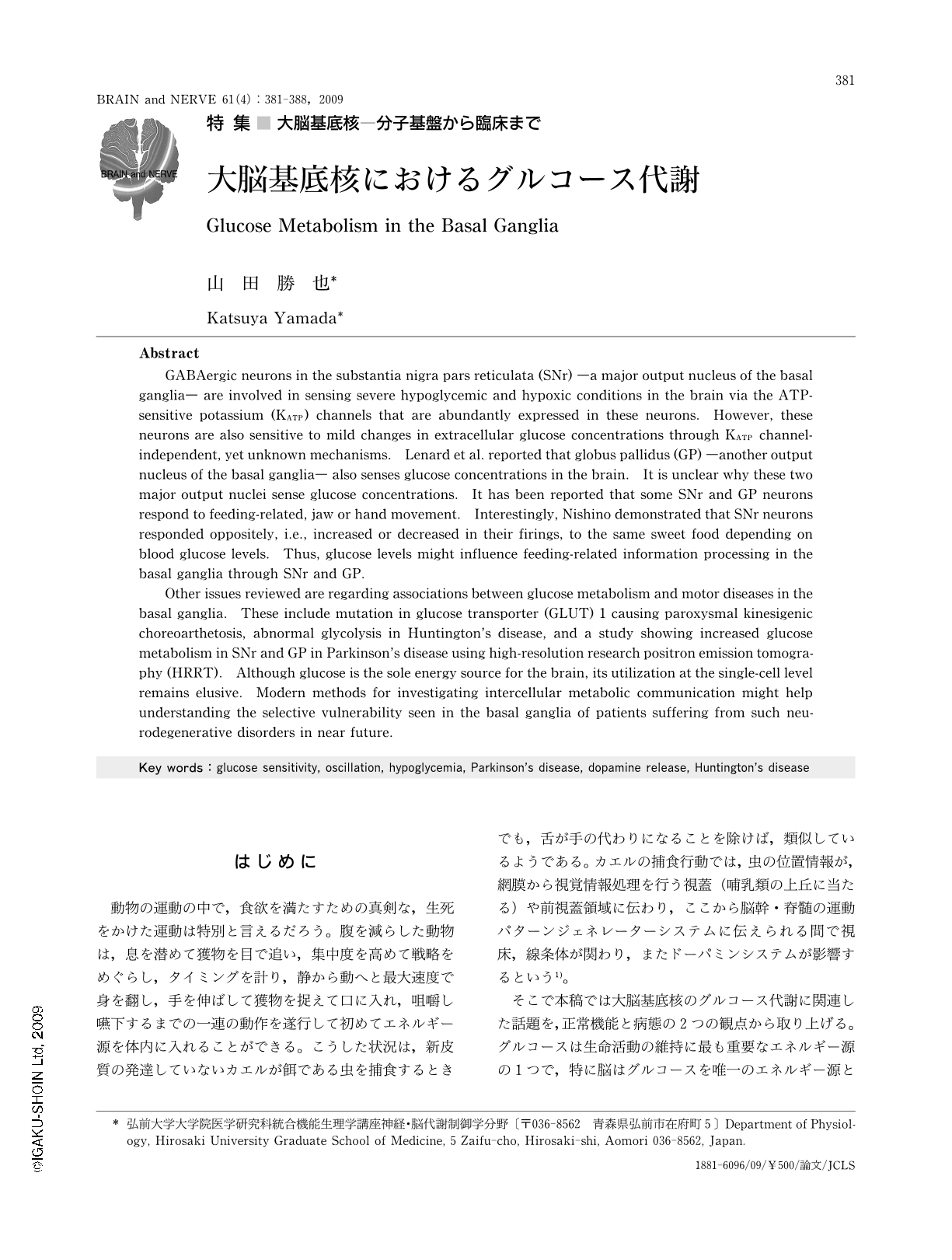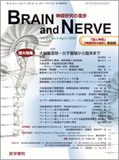Japanese
English
- 有料閲覧
- Abstract 文献概要
- 1ページ目 Look Inside
- 参考文献 Reference
はじめに
動物の運動の中で,食欲を満たすための真剣な,生死をかけた運動は特別と言えるだろう。腹を減らした動物は,息を潜めて獲物を目で追い,集中度を高めて戦略をめぐらし,タイミングを計り,静から動へと最大速度で身を翻し,手を伸ばして獲物を捉えて口に入れ,咀嚼し嚥下するまでの一連の動作を遂行して初めてエネルギー源を体内に入れることができる。こうした状況は,新皮質の発達していないカエルが餌である虫を捕食するときでも,舌が手の代わりになることを除けば,類似しているようである。カエルの捕食行動では,虫の位置情報が,網膜から視覚情報処理を行う視蓋(哺乳類の上丘に当たる)や前視蓋領域に伝わり,ここから脳幹・脊髄の運動パターンジェネレーターシステムに伝えられる間で視床,線条体が関わり,またドーパミンシステムが影響するという1)。
そこで本稿では大脳基底核のグルコース代謝に関連した話題を,正常機能と病態の2つの観点から取り上げる。グルコースは生命活動の維持に最も重要なエネルギー源の1つで,特に脳はグルコースを唯一のエネルギー源として血中から取り込む。実際グルコースの極端な低下が続けば危険な脳の全般発作(generalized seizure)が起きて脳に致命的ダメージを与える2)。最近,大脳基底核の出力核に当たる黒質網様部(substantia nigra pars reticulata:SNr)は,グルコースや酸素が欠乏し出すと鋭敏に検知して,エネルギー消費が大きい全般発作を抑え,脳を保護する役目を果たすことがわかってきた3,4)。また,日常生活において食後に上昇し,空腹時には低下する血中グルコース濃度の変動に合わせて,脳内のグルコース濃度も上下し5),こうしたグルコース濃度の穏やかな変動も,黒質網様部や淡蒼球で直接検知されている可能性がある4,6,7)。
基底核の第一の機能は運動制御であるが8),古くから報告されているように黒質網様部や淡蒼球には,特に摂食に関連した動作に応答するニューロンが存在する9)。さらに,黒質には血糖値に依存して摂食関連動作時の神経応答が逆転するニューロンもある9)。そのほかにも,黒質網様部と顎運動との関連を示した報告は多い10)。そこで本稿では最初にこうした問題に焦点を当てる。
推測だが,哺乳類でも空腹時にグルコースが低下した際,基底核が感知して捕食行動に最高のパフォーマンスを発揮できるように視蓋感覚系と脳幹運動系をコーディネートし,一方でグルコース摂取に応答して報酬感覚を与えて動作を強化すると考えられないだろうか11)。関連して最近,甘味受容のできないマウスが甘いショ糖に対して嗜好性を示す理由として,ショ糖摂取によるグルコース上昇が脳で直接的に感知されてドーパミン放出を亢進させるとの説が現れた12)。基底核のグルコース感知能と連動している可能性もあり興味深い。
本稿のもう1つの焦点は,基底核疾患とグルコース代謝障害の関係である。グルコーストランスポーター(GLUT)1の変異により,グルコース輸送が障害されて舞踏病アテトーゼを発症した家系13),また早期のハンチントン舞踏病(Huntington's disease)患者の解糖系に代謝障害があることを示唆した報告14),新世代の陽電子断層法(positron emission tomography:PET)で,パーキンソン病患者の黒質と淡蒼球におけるグルコース利用の亢進を検出した例15)など,基底核疾患にグルコース代謝が深く関わっていることを示唆する最近の話題を取り上げる。
遺伝子変異が同定されても,なぜ特定領域で神経変性を導くのかはまだ難問である16)。この問題を解くうえで,脳機能を代謝系との関わりの中で理解しようとする基礎研究が役立つかもしれない。ただしグルコースと脳の関係には,そもそもニューロンのシナプス活動にグルコースが直接使用されているかどうかなど,依然多くの謎がある。そこで最後に蛍光を用いることで,グルコース輸送を単一細胞レベルで検出しようとする最近の試みについて触れ17,18),現況を概観すると共に今後を展望する。
Abstract
GABAergic neurons in the substantia nigra pars reticulata (SNr) ―a major output nucleus of the basal ganglia― are involved in sensing severe hypoglycemic and hypoxic conditions in the brain via the ATP-sensitive potassium (KATP) channels that are abundantly expressed in these neurons. However, these neurons are also sensitive to mild changes in extracellular glucose concentrations through KATP channel-independent, yet unknown mechanisms. Lenard et al. reported that globus pallidus (GP) ―another output nucleus of the basal ganglia― also senses glucose concentrations in the brain. It is unclear why these two major output nuclei sense glucose concentrations. It has been reported that some SNr and GP neurons respond to feeding-related, jaw or hand movement. Interestingly, Nishino demonstrated that SNr neurons responded oppositely, i.e., increased or decreased in their firings, to the same sweet food depending on blood glucose levels. Thus, glucose levels might influence feeding-related information processing in the basal ganglia through SNr and GP.
Other issues reviewed are regarding associations between glucose metabolism and motor diseases in the basal ganglia. These include mutation in glucose transporter (GLUT) 1 causing paroxysmal kinesigenic choreoarthetosis,abnormal glycolysis in Huntington's disease,and a study showing increased glucose metabolism in SNr and GP in Parkinson's disease using high-resolution research positron emission tomography (HRRT). Although glucose is the sole energy source for the brain,its utilization at the single-cell level remains elusive. Modern methods for investigating intercellular metabolic communication might help understanding the selective vulnerability seen in the basal ganglia of patients suffering from such neurodegenerative disorders in near future.

Copyright © 2009, Igaku-Shoin Ltd. All rights reserved.


